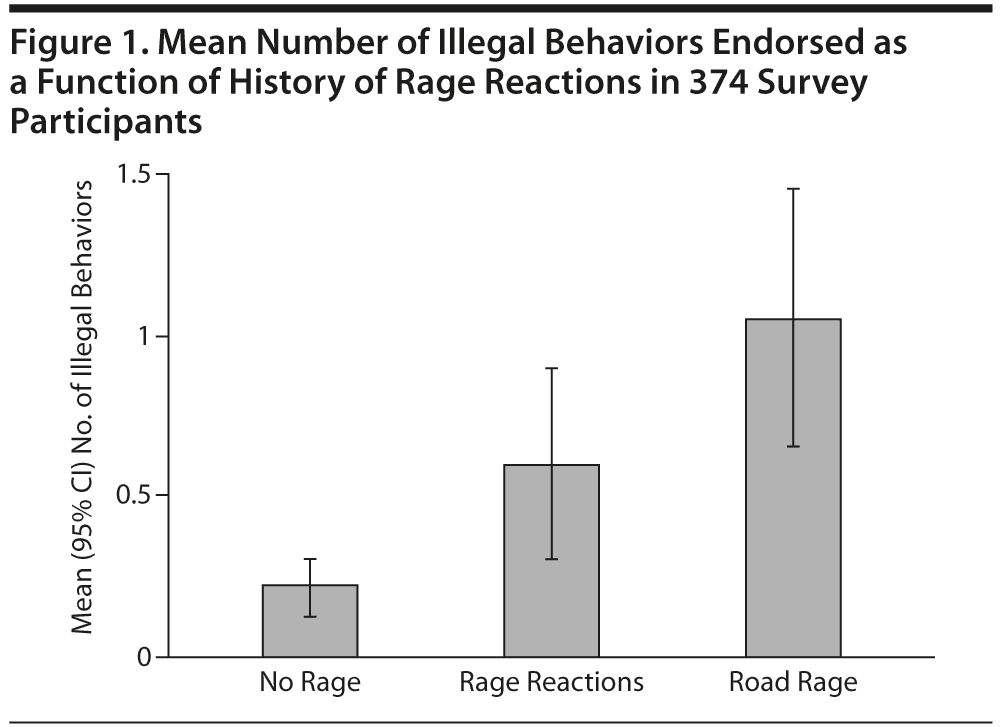Relationship Between Rages and Criminal Behavior in an Internal Medicine Outpatient Sample
To the Editor: To our knowledge, the relationship between episodes of rage and past criminal behaviors has not been explored. Toward this end, we conducted a survey in which the participants were adults seen at an outpatient internal medicine clinic staffed predominantly by residents.
Method. At the outset of the survey, which was conducted in October 2010, 471 individuals were approached, and 417 (88.5%) agreed to participate. Of these, 374 individuals completed study measures: 128 men and 246 women, ranging in age from 19 to 97 years (mean = 50.11, SD = 15.41). Most of the respondents were white (88.0%), followed by African American (7.8%). All but 5.9% of respondents reported having attained at least a high school diploma; 14.6% reported having a bachelor’s degree.
One of the authors (C.L.) approached incoming patients in the lobby and invited study candidates to complete a 5-page survey that included questions pertaining to (1) demographic information, (2) rage reactions (ie, "Have you ever had any rage reactions—ie, out-of-control, amplified anger?") and road rages ("Have you ever had any road rages—ie, violent uncontrolled anger while driving?"), and (3) charges (not convictions) for 27 crimes (eg, aggravated assault, arson, simple assault, burglary, and disorderly conduct; none were routine traffic offenses) as delineated by the Federal Bureau of Investigation.1 Most of the legal charges included a brief definition, and all had yes/no response options.
This project was reviewed and exempted by the institutional review boards of the study site as well as the local university. The elements of informed consent were provided on the cover page of the booklet, which indicated that completion of materials was assumed to be informed consent.
Results. Of the 374 respondents, 189 (50.5%) reported no past rages, 95 (25.4%) reported past rage reactions but not in the context of driving, and the remaining 90 (24.1%) indicated having had road rages (with or without rage reactions). The number of past and different illegal behaviors with which participants reported being charged ranged from 0 to 13 (mean = 0.57, SD = 1.63), with most participants (78.6%) reporting 0 charges.
Because only 6 respondents endorsed 7 or more illegal behaviors, we truncated scores at 7 to prevent an undue statistical influence before performing a Kruskal-Wallis test on the measure of legal charges as a function of rage history. The overall result was statistically significant (χ22 = 19.03, P < .001; Figure 1). Follow-up Mann-Whitney tests revealed statistically significant differences between respondents with no rages compared to those with rage reactions (d = 0.29, Z = 2.35, P < .02) and road rages (d = 0.64, Z = 4.35, P < .001). The difference between respondents with rage reactions compared to road rages was not statistically significant (d = 0.35, Z = 1.72, P < .10).
Findings of this study indicate that rages, particularly road rages, heighten the probability of a history of illegal behavior. The study has a number of potential limitations, including the untested self-report measures for rage history and past criminal charges. However, the findings are novel to the literature and indicate that rage is potentially intertwined with criminal behavior.
Reference
1. Federal Bureau of Investigation. Uniform Crime Reporting Handbook. http://www2.fbi.gov/ucr/handbook/ucrhandbook04.pdf. Accessed March 24, 2010.
Author affiliations: Departments of Psychiatry and Internal Medicine, Wright State University School of Medicine, Dayton, Ohio (Dr Sansone); Department of Psychiatry Education (Dr Sansone) and Transition-Year Program (Dr Lam), Kettering Medical Center, Kettering, Ohio; and Department of Human Relations, Columbia College, Columbia, South Carolina (Dr Wiederman).
Potential conflicts of interest: None reported.
Funding/support: None reported.
Published online: March 14, 2013.
Prim Care Companion CNS Disord 2013;15(2): doi:10.4088/PCC.12l01393
© Copyright 2013 Physicians Postgraduate Press, Inc.




